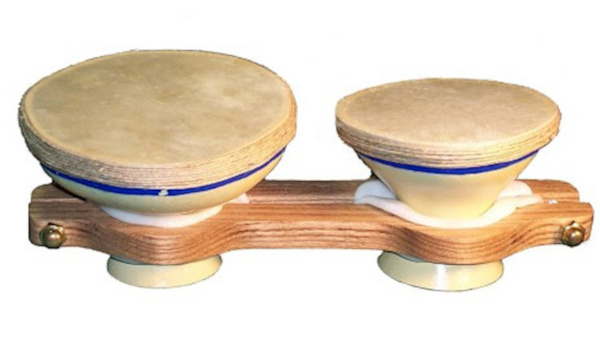Gourd Bongos are essentially two Basic Hand Drums of dissimilar size that produce two different pitches, paired in some way to imply that they are a set.
When entertaining ideas for building a new instrument or a novel approach to constructing an existing one, solutions to constraints that do not involve the mechanism of sound generation can be somewhat arbitrary. In this case, since “pairing” the Gourd Bongos doesn’t appear to effect the vibration of the drum’s membrane*, any particular solution to the “pairing” constraint is left to the discretion of the maker. When two gourd drums of dissimilar size are in close proximity to each other, do they become bongos? Could painting two drums the same color imply that they are a set? Do two gourd drums with different pitches, played over a video conference call by people in different cities qualify as a bongo session? You’re answers may be yes or no to all or some of these questions, and whatever your answers are, you’re right!
So what is gained by pairing a couple of drums of different sizes? If a single Basic Hand Drum provides three basic tones (slap, bass, and tone) you’ve doubled your degrees of freedom to six by adding a second drum with a different pitch. The pitch difference between the two drums also allows for more interesting phrasing, more complicated rhythms, and rapid soloing. Bongo drums are often heard in Cuban music, Afro-Cuban jazz, Latin music, funk, hip-hop (consider the classic break beat sampled from Apache by the Incredible Bongo Band), psychedelic rock and all kinds of experimental music. While the exact origin of bongo drums is unknown, they were first documented in Cuba during the late 19th century, and were likely derived from Central African, open bottom, drum models1.

Tackling a pair of Gourd Bongos is not only great practice for building Basic Hand Drums, but they are an excellent, and forgiving, foray into incorporating woodworking into instrument design. Since the frame doesn’t effect the method of generating sound too greatly, the only thing you really need to decide is how the frames should fit around the gourds. The frame we designed to join our Gourd Bongos is shown in Figure 1. It’s pretty utilitarian, but it could be as crazy as you like. One of the problems encountered by joining a pair of bongos with something other than a frame (e.g. typing hemp around their waists), is that it can be difficult to balance the two drums in a way that the open ended bottoms remain exposed while playing. Using a frame not only holds the two drums in place, but also acts a stand of sorts, allowing the vibrations of the membrane to move through the column and out the bottom of the shell unimpeded.

Woodworking opportunities present themself in all kinds of DIY instrument designs. For a couple of examples where woodworking is used to construct the primary method of sound generation, check out the tone bars of the Güirophone and the Electric Güirophone. Elsewhere in the world of DIY instrument making, Cigar Box Guitars (Figure 2. shows a Cigar Box Fiddle, but the principle is similar), are great projects for getting into strings. Cigar Box Guitars come in a variety of flavors, but their necks and headstocks are typically made of wood. In fact, the neck and headstock are the main things fabricated when building a Cigar Box Guitar, usually from a single piece of wood. The level of precision required to build a cigar box guitar is certainly greater than that of the Gourd Bongos frame, but the basic tools (jigsaw, files, rasps, drills, square, level, etc.) and techniques (measuring, cutting, drilling, sanding, etc.) are universal when incorporating woodworking in instrument making.
* Things like gripping a gourd drum’s shell too tight or applying excessive padding around it (wrapping it in heavy cloth, for example) does, in fact, impact a drum’s timbre.
References:
- Wikipedia contributors. “Bongo drum.” Wikipedia: The Free Encyclopedia. 20 April 2021. en.wikipedia.org/wiki/Bongo_drum. Accessed 15 July 2021.
- Daderot. “Cigar box fiddle – Museum of International Folk Art – DSC09182.JPG.” Public domain, via Wikimedia Commons. 18 July 2011. https://commons.wikimedia.org/wiki/File:Cigar_box_fiddle_-Museum_of_International_Folk_Art-_DSC09182.JPG#file. Accessed 15 July 2021.
